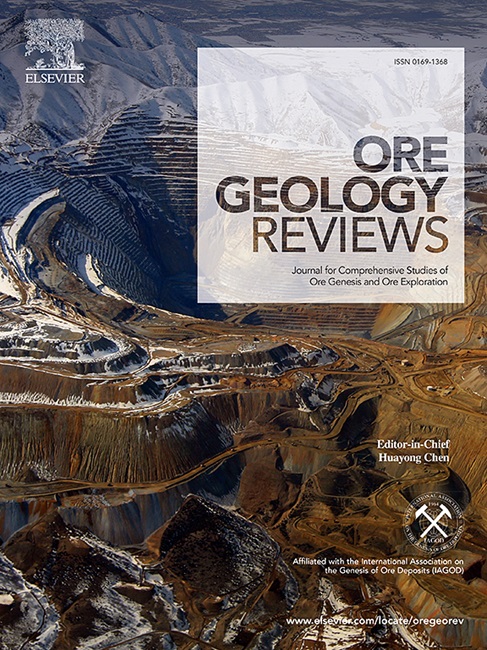Genesis and mineralization processes of the Hua’aobaote Pb–Zn–Ag polymetallic deposit in Inner Mongolia: Constraints from in situ sulfur isotopes and trace elements in pyrite
IF 3.2
2区 地球科学
Q1 GEOLOGY
引用次数: 0
Abstract
The Hua’aobaote Pb–Zn–Ag deposit in the Southern Great Xing’an Range (SGXR) was recently discovered, and its orebodies occur in Permian tuffaceous siltstone, sandstone, siltstone, and slate and are strictly controlled by faults. The aim of this study is conduct trace element and sulfur isotope analyses of pyrite to accurately delineate the mineralization process from magmatic to hydrothermal stages, enhancing the understanding of the genesis of the deposit. The research findings reveal that the mineralization process can be categorized into three stages: pyrite + quartz (Py1), quartz + pyrite + arsenopyrite + chalcopyrite + cassiterite + pyrrhotite + galena + sphalerite + silver minerals (Py2), and quartz + pyrite + arsenopyrite + marcasite + calcite (Py3). Within these stages, Py1 displays the highest concentrations of Se and Ni (averages of 352.05 ppm and 28.71 ppm), whereas other trace elements are relatively scarce. Conversely, the total trace element contents in Py2 and Py3 significantly increase, particularly those of Cu, Sn, Ag, Pb, Zn, Bi, Mn, As, and Sb. Notably, Py2 has the highest concentrations of Co (average of 20.39 ppm), Bi (average of 14.34 ppm), and Sn (average of 17.78 ppm), whereas Py3 is characterized by a uniquely high Mn concentration (average of 154.34 ppm). The δ34S values for pyrite, ranging from −2.96 ‰ to 1.55 ‰, are characteristics of deep magma sources. Py1 is distinguished by high Se and low As contents, elevated Se/As and Co/Sb ratios, and comparatively low Sb/Bi and As/Ag ratios. These characteristics suggest that Py1 comprises magmatic pyrite and hydrothermal pyrite, formed through the evolution of porphyry-type magmatic fluids. In contrast, Py2 and Py3 are hydrothermal pyrites that have high As and low Se contents, low Se/As and Co/Sb ratios, and high Sb/Bi and As/Ag ratios. These features indicate their formation in an epithermal environment, likely resulting from interactions between magmatic fluids and host rocks or meteoric water. An analysis of mineral assemblages, trace elements, and sulfur isotopes indicates that the mineralization occurred from mid- to high-temperature, mid-sulfidation porphyry magmatic fluids to low-temperature, low-sulfidation hydrothermal fluids, indicating that the ore-forming materials originated predominantly from porphyry magma. Accordingly, the Hua’aobaote deposit is categorized as a distal, mid- to low-temperature, mid- to low-sulfidation epithermal vein deposit linked to a porphyry-type magmatic–hydrothermal system.

求助全文
约1分钟内获得全文
求助全文
来源期刊

Ore Geology Reviews
地学-地质学
CiteScore
6.50
自引率
27.30%
发文量
546
审稿时长
22.9 weeks
期刊介绍:
Ore Geology Reviews aims to familiarize all earth scientists with recent advances in a number of interconnected disciplines related to the study of, and search for, ore deposits. The reviews range from brief to longer contributions, but the journal preferentially publishes manuscripts that fill the niche between the commonly shorter journal articles and the comprehensive book coverages, and thus has a special appeal to many authors and readers.
 求助内容:
求助内容: 应助结果提醒方式:
应助结果提醒方式:


